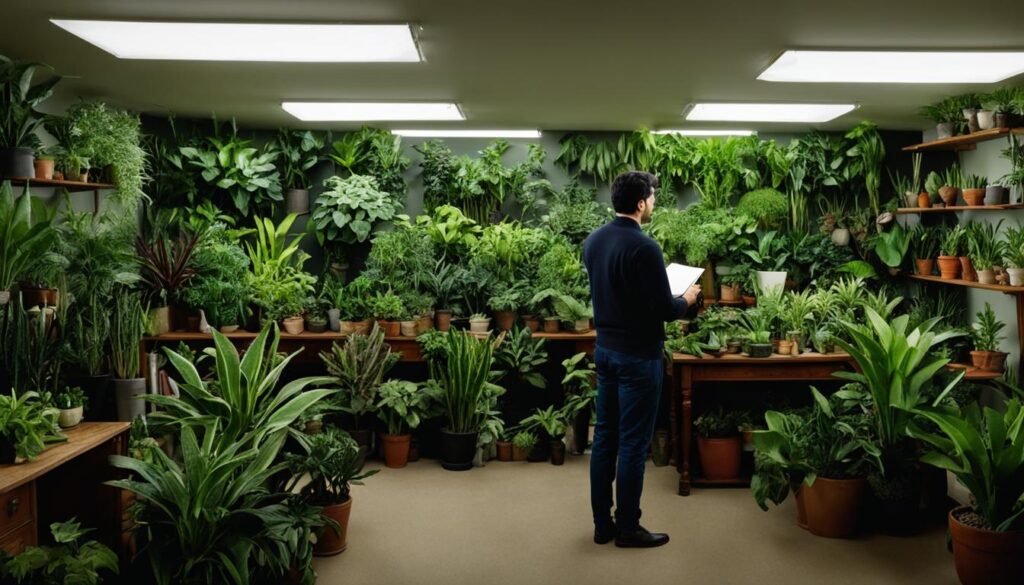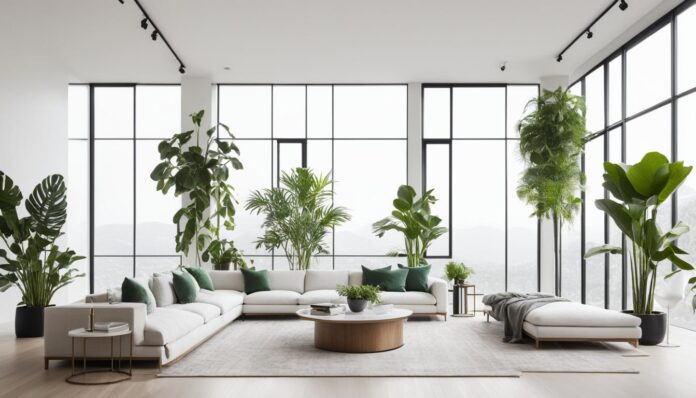Are you looking to refresh your home decor? Consider the power of houseplants and how they can transform any space. One often overlooked factor in plant care and growth is the color of your walls. Believe it or not, the color of your walls can have a significant impact on the health and vigor of your houseplants. In this article, we will explore the relationship between white walls, green thumbs, and the art of decorating with houseplants.
Key Takeaways:
- White or light-colored walls reflect light, providing more energy for plant growth.
- Dark walls absorb more light, resulting in stunted and pale plants.
- Bright walls benefit not only decorative plants but also vegetable and flower seedlings.
- Decorating with houseplants adds character to your living space.
- Houseplants have health benefits, such as purifying the air and reducing stress.
The Benefits of Decorating with Plants
Decorating your home with plants goes beyond aesthetics. Houseplants offer numerous health benefits, transforming your living space into a lush sanctuary. The presence of indoor greenery introduces a sense of tranquility and serenity, bringing nature indoors.
Indoor plants act as natural air purifiers, enhancing the quality of the air you breathe. They absorb toxins and release oxygen, resulting in cleaner and fresher indoor air. This not only promotes better respiratory health but also reduces the risk of allergies and respiratory conditions.
Aside from their air-purifying abilities, plants have been proven to reduce stress and boost mood. The mere presence of greenery has a soothing effect on the mind and body, helping to calm nerves and create a peaceful atmosphere. Studies have shown that spending time with plants can lower physiological and psychological stress levels, promoting overall well-being.
Furthermore, plants have the power to improve productivity and focus. The natural elements and vibrant colors of indoor greenery stimulate the senses and create a more invigorating environment. Whether it’s a desk plant or a larger botanical display, incorporating plants into your workspace can enhance concentration and creativity.
“The presence of indoor plants introduces a sense of tranquility and serenity, bringing nature indoors.”
Aside from their health benefits, plants add character and personality to living spaces. Whether you prefer a minimalist style or an eclectic aesthetic, there is a plant to suit every design preference. From cascading vines to sculptural succulents, each plant brings its own unique charm and visual appeal.
Indoor greenery also offers the opportunity for creative expression. You can experiment with different plant arrangements, hanging planters, or even create a vertical garden. The options are endless, allowing you to tailor your plant decor to suit your personal style.
In summary, decorating with plants not only enhances the visual appeal of your home but also provides a multitude of health benefits. From purifying the air to reducing stress and boosting productivity, indoor greenery plays a crucial role in creating a harmonious and nurturing living environment.
Choosing the Right Plants for Your Space

When it comes to adding indoor plants to your space, selecting the right ones is essential. Factors such as lighting conditions and maintenance requirements play a crucial role in determining which plants will thrive in your home or office. By considering these aspects, you can choose plants that not only enhance the aesthetics but also flourish in their environment.
Light Conditions
The amount of light available in a room is a key factor in plant selection. Some plants, like succulents and cacti, thrive in bright, direct sunlight. If you have a sunny spot with abundant natural light, these plants will be a perfect fit. On the other hand, if your space has lower light levels or limited access to natural light, you should opt for plants that can thrive in such conditions. Snake plants and peace lilies are known for their ability to tolerate lower light levels, making them ideal choices for areas with less sunlight.
Maintenance
Another crucial aspect to consider is the level of maintenance required by different plants. If you have a busy schedule or are new to plant care, choosing low-maintenance options can be a wise decision. ZZ plants and pothos are excellent choices for those who want plants that can thrive with minimal attention. These plants are known for their resilience and adaptability. However, if you have the time and dedication to provide extra care, plants like orchids and ferns can reward you with their lush foliage and vibrant blooms.
Remember that each plant has its unique needs and preferences. By selecting plants that align with the lighting conditions and maintenance capabilities of your space, you can create a thriving indoor garden that adds beauty and vitality to your surroundings.
Creative Ways to Decorate with Plants
Looking to add a touch of nature to your home decor? There are plenty of creative and stylish ways to incorporate plants into your living spaces. Whether you have a small apartment or a spacious house, plants can bring life and beauty to any room. Here are some inspirational ideas for creative plant decor:
Hanging Plants
Add a boho touch or make the most of limited space with hanging plants. Macramé plant hangers are a popular choice, allowing you to suspend plants from the ceiling or walls. Hang them in clusters or mix different plant species for a dynamic display. Not only do hanging plants add visual interest, but they also help create a sense of verticality in your space.
Shelfie Plants
Create a captivating display by arranging plants on shelves. Mix and match different species and pot colors to add depth and variety. Shelfie plants can be grouped together or placed individually at different heights to create an eye-catching composition. This is a great way to showcase your plant collection and add a touch of greenery to blank walls.
Terrariums
Elevate your creativity with terrariums, miniature ecosystems encapsulated in glass containers. Customize your terrariums with small plants, pebbles, moss, and other decorative elements. These enchanting displays add a unique touch to any space and make for excellent conversation starters. Explore different shapes and sizes to suit your personal style.
Plant Walls
Bring a piece of nature indoors by creating plant walls. Transform a blank wall into a stunning vertical garden by attaching a variety of plants. Alternatively, opt for a smaller accent wall with plant frames or mounted planters. Plant walls add a refreshing and vibrant backdrop to any room and can turn even the simplest spaces into lush sanctuaries.
Plant Corners and Window Sills
Maximize the impact of decorative plants by placing them in corners or on window sills. These areas provide ample light and space for showcasing your green treasures. Whether it’s a leafy palm or a vibrant flowering plant, a well-positioned plant can instantly elevate the aesthetic of a room. Consider using plant stands or decorative pots to elevate your display.
Get creative with your plant decor and let your imagination run wild. Whether it’s hanging plants, terrariums, or plant walls, there’s no shortage of innovative ways to incorporate decorative plants into your home. These green accents will not only add beauty but also freshen the air and create a calming atmosphere.
Caring for Your Plants
Proper plant care is crucial for maintaining healthy and thriving indoor plants. Taking care of plants involves understanding their specific needs in terms of watering, sunlight, temperature, and humidity.
Watering
When it comes to watering your plants, it’s important to research the specific watering needs of each plant. Overwatering can be detrimental to plant health, as it can lead to root rot and other issues. On the other hand, underwatering can cause dehydration and stunted growth.
Here are some general guidelines for watering common houseplants:
- Check the moisture level of the soil before watering. Stick your finger about an inch into the soil; if it feels dry, it’s time to water.
- Water thoroughly until water drains out from the bottom of the pot. This ensures that the roots receive adequate hydration.
- Avoid leaving plants sitting in standing water, as it can lead to root rot. Discard any excess water that collects in saucers or trays.
Sunlight and Temperature
Each plant has different light requirements, so it’s essential to place them in areas with the appropriate amount of sunlight. Some plants thrive in direct sunlight, while others prefer indirect or low light conditions. Consider the following:
- Place sun-loving plants near windows or areas that receive ample sunlight throughout the day.
- Indoor spaces with limited natural light can benefit from the use of artificial grow lights.
In addition to sunlight, temperature plays a key role in plant care. Most houseplants prefer a relatively consistent temperature range between 60°F and 75°F (15°C and 24°C).
Humidity
Humidity levels can greatly influence plant health, especially for tropical plants. While some plants thrive in higher humidity, others, such as cacti, prefer drier environments. Consider the following tips:
- Grouping plants together can create a microclimate of higher humidity.
- Misting the leaves of plants or placing a tray filled with water near them can help increase humidity levels.
Understanding your plants’ humidity preferences can help ensure they thrive in the appropriate environment.
Fertilizing, pruning, and cleaning the leaves are additional aspects of plant care that contribute to optimal growth. Fertilizers provide essential nutrients, pruning helps maintain shape and encourages new growth, while cleaning leaves removes dust and allows plants to breathe.
Remember, different plants have different care requirements. It’s essential to research the specific needs of each plant to ensure you provide the best possible care.
Decorating Tips and Conclusion
When it comes to decorating with plants, the possibilities are endless. Embrace your creativity and let your personal style shine through. Experiment with different placement options and pot arrangements to transform your living spaces into a lush green oasis.
As you embark on your plant-filled journey, remember to consider your overall interior design aesthetic. Incorporate plants as accents to enhance the space and create a harmonious environment. Whether you prefer a modern minimalist style or a cozy bohemian vibe, there’s a plant for every design preference.
What truly makes decorating with plants special is the tranquility and joy they bring. The presence of greenery in your home can have a calming effect, creating a serene atmosphere. No matter the number or arrangement of your plants, their beauty lies in the sense of peace they provide.
So, go ahead and invite some greenery into your living spaces. Let the plants work their magic, transforming your house into a green oasis of tranquility. Enjoy the process of nurturing and caring for your botanical companions. Happy decorating!
FAQ
How does the color of the walls affect the growth of houseplants?
Dark walls absorb more light and can result in stunted and pale plants, while white or light-colored walls reflect light, providing more energy for plant growth.
What are the health benefits of decorating with plants?
Houseplants act as natural air purifiers, absorbing toxins and releasing oxygen, resulting in cleaner and fresher indoor air. They also reduce stress levels and boost mood and productivity.
How do I choose the right plants for my space?
Consider the lighting conditions and your ability to care for them. Some plants thrive in bright, direct sunlight, while others prefer lower light levels. Also, take into account the maintenance requirements of the plants.
What are some creative ways to decorate with plants?
You can hang plants in macramé plant hangers, arrange them on shelves in a mix of different species and pot colors, create terrariums, or incorporate plant walls as vertical gardens or accent walls.
How do I care for my indoor plants?
Proper plant care includes researching the specific watering needs of each plant and avoiding overwatering. Additionally, make sure to place them in areas with the appropriate amount of sunlight and consider their temperature and humidity preferences.

